The Age of Enlightenment: an introduction
Read Now >Chapter 65
Empires and their endings in the late 18th and 19th centuries
England, France, India, and Africa
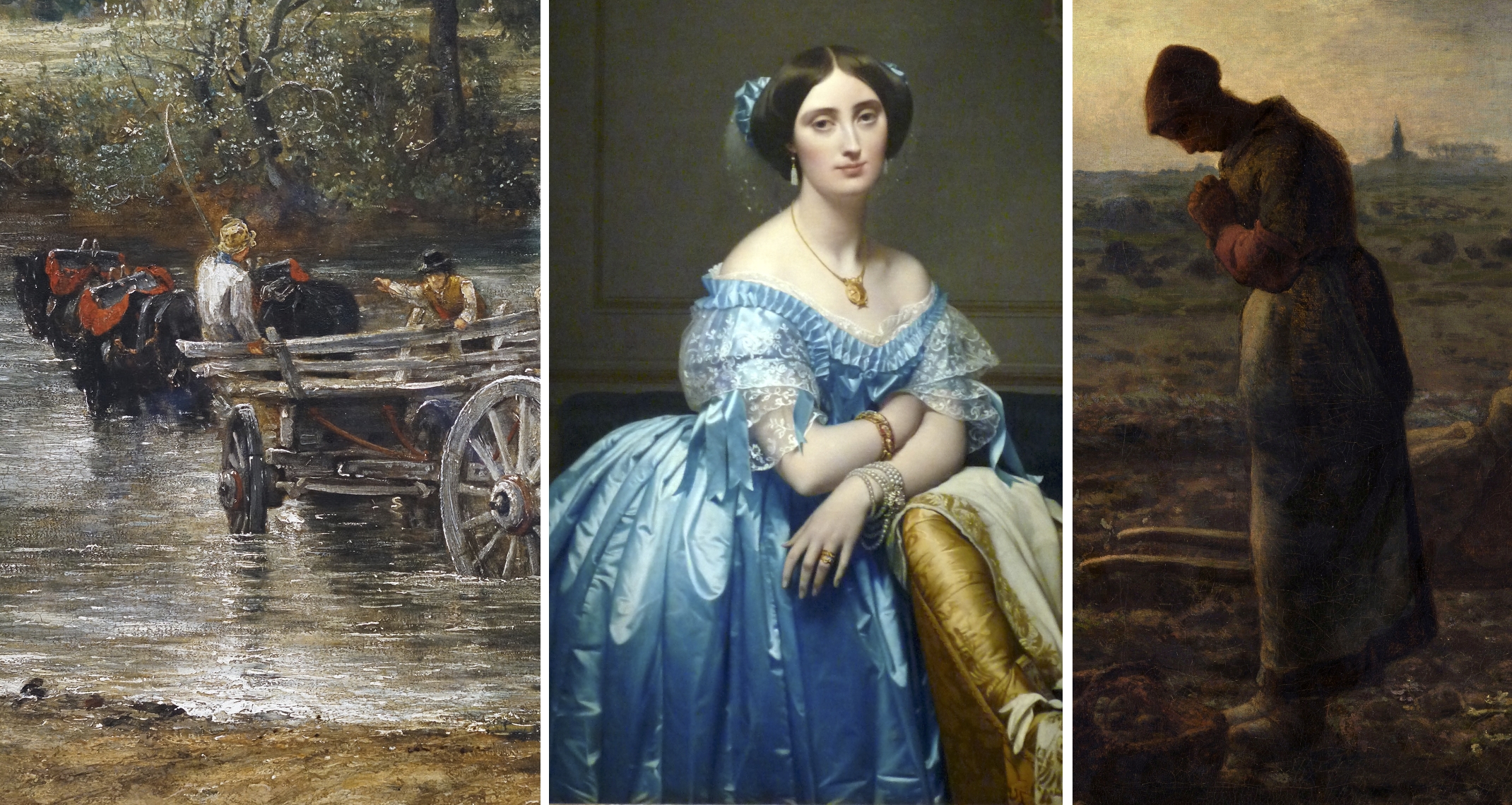
Left: Detail, John Constable, The Hay Wain (Landscape: Noon), 1821, oil on canvas, 130.2 x 185.4 cm (The National Gallery, London); center: Jean-Auguste-Dominique Ingres, Princesse de Broglie, 1851–53, oil on canvas, 121.3 x 90.8 cm (The Metropolitan Museum of Art; right: Jean-François Millet, L’Angélus, c. 1857–59, oil on canvas, 53.3 × 66.0 cm (Musée d’Orsay, Paris)
Horses and haycarts crossing country streams, pale women in elegant gowns, peasants at prayer. Images like these create an impression that nineteenth-century Europe was a quiet, orderly world that celebrated its accomplishments and shared little with people and cultures outside of itself. In reality, life for most people meant long hours of work, day in and day out, with little security. At the end of the eighteenth century, citizens began to take control of their futures through self-government and one result was revolutions in the American colonies, France, and Haiti.
The first decades of the nineteenth century (1800–1830), the main subject of this chapter, saw Europe rocked by the defeat of a short-lived French empire that followed a revolution, and an expansion of European trade and political power that stretched across the globe. Through the art of this time in Europe, we can see dreams of equality and self-governance confront the brutality of war, slavery, and the goals of international trade. As artists explored this changing world they began to understand Europe as a place that had grown beyond its geographic boundaries with contacts in North Africa, India, and elsewhere across the globe. We also see Neoclassicism—a style of art believed to reflect the ideals of Enlightenment and democracy at first—become the artistic language of empire.
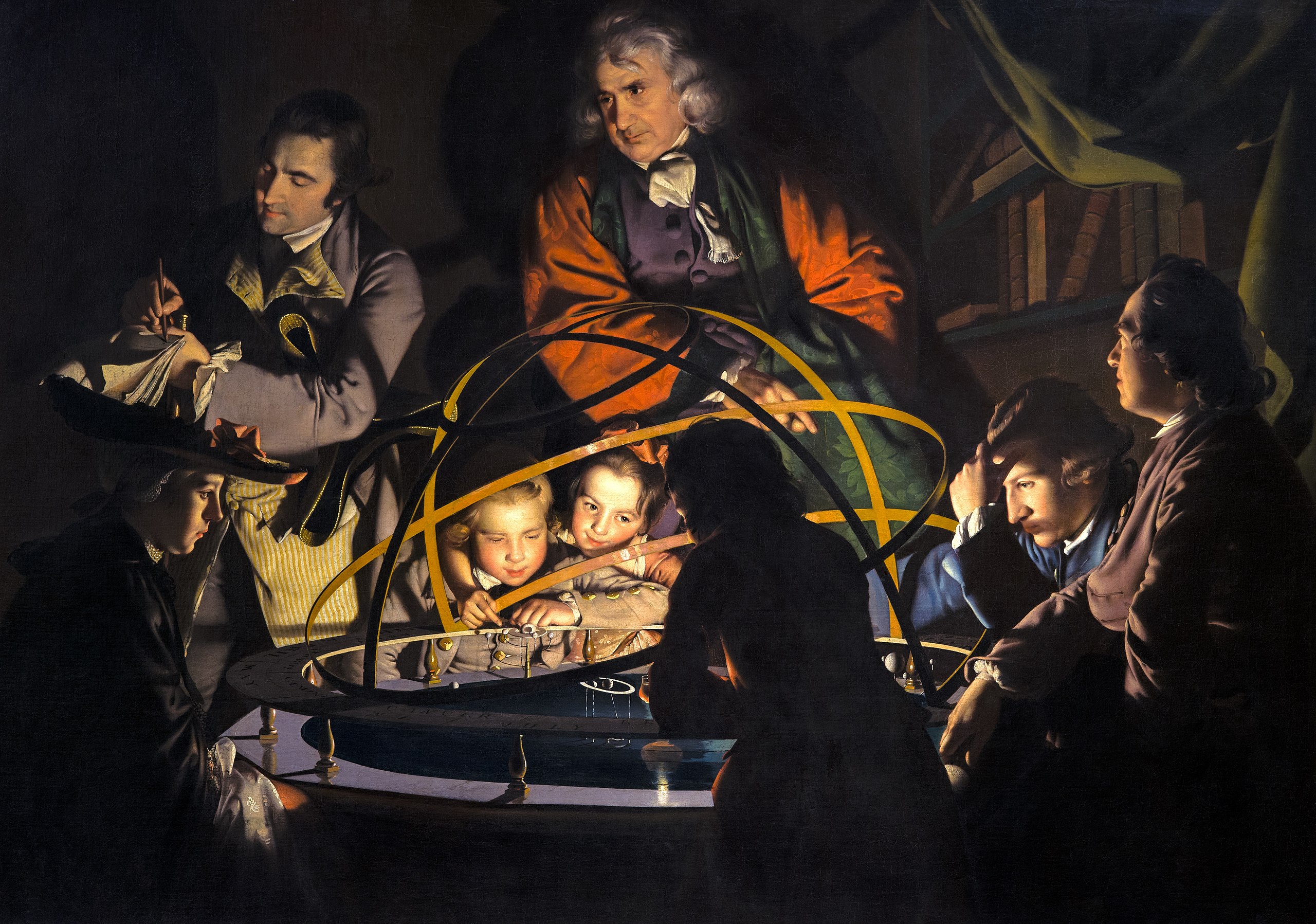
Joseph Wright of Derby, A Philosopher Giving a Lecture at the Orrery (in which a lamp is put in place of the sun), c. 1763–65, oil on canvas, 4′ 10″ x 6′ 8″ (Derby Museums and Art Gallery, Derby, photo: Hohum, public domain)
Coming out of the Enlightenment: The call for self-governance
Central to the development of art in nineteenth-century Europe was a shift in thinking during the eighteenth century, known as the Enlightenment, that championed reason as means to understand and explain a rapidly changing world. As the essay “The Age of Enlightenment, an introduction” notes, this new way of thinking about society and government reflected developments in science and technology. This approach was rooted in logic and experience, rather than religious faith or unquestioned traditions. Many of the political events and changes in art during the first decades of the nineteenth century grew out of these new ideas. The Enlightenment offered an alternative way of interpreting the role of citizens in a society. Instead of being the subjects of their ruler, in a world dominated by the Christian religion that supported the “divine right” of kings, Enlightenment thinkers argued that citizens were born with natural rights and an ability to govern themselves. One consequence of the Enlightenment was a renewed interest in the Classical world (the cultures of Ancient Greece and Rome) as a model for modern European self-governance.
Read an introductory essay
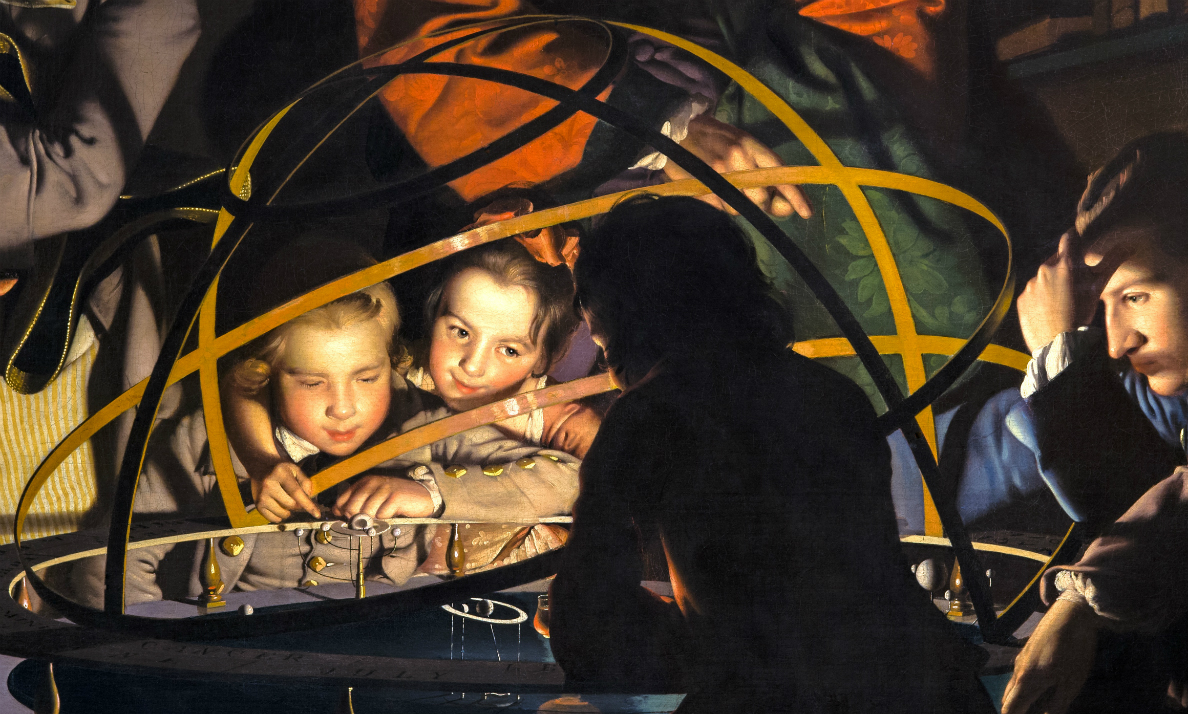
0/1 Completed
Winckelmann and Ancient Greece
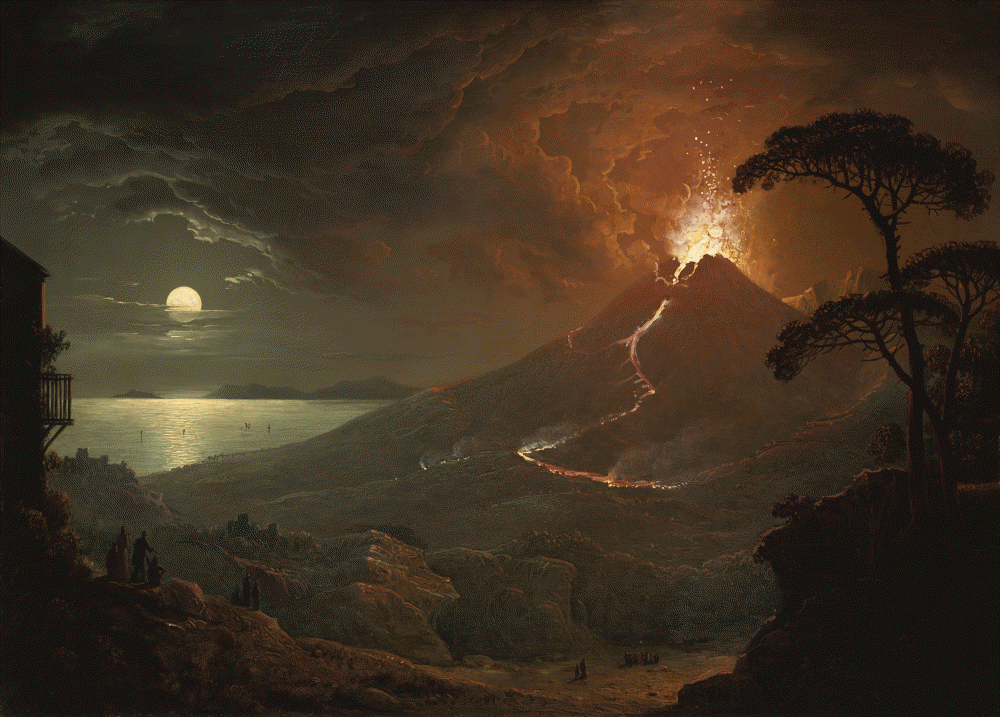
Vesuvius erupted in the late 1700s and early 1800s. Though the artist travelled to Italy to paint the volcano, he depicted here the one eyewitness account of the eruption in 79 C.E. Sebastian Pether, The Eruption of Vesuvius, 1825, oil on wood panel (The Nelson Atkins Museum of Art)
The interest in the art and culture of the Classical world developed in Europe with the excavation of Pompeii during the 1780s, as explored in the following essay about the rediscovery of the city. A German antiquarian and writer living in Rome, Johann Joachim Winckelmann, discussed the art of Greeks and, to a lesser extent, the Romans in books that were “must-reads” for any European interested in the new style for fashion, art, and architecture, Neoclassicism. For Winckelmann, the Greeks were innately virtuous and, by extension, “naturally” capable of the self-governance that characterizes democracy. Neoclassic art—meaning “new classicism”—was art that emulated the style of the ancient Greeks and Romans and, so, expressed their values as well. Today, this emphasis on the world of Greece and Rome in Western education is a subject of great debate as is the incorrect assumption that the sculptures and temples of Ancient Greece were uniformly white (they were often brightly painted).
Read about the interest in the art and culture of the Classical world
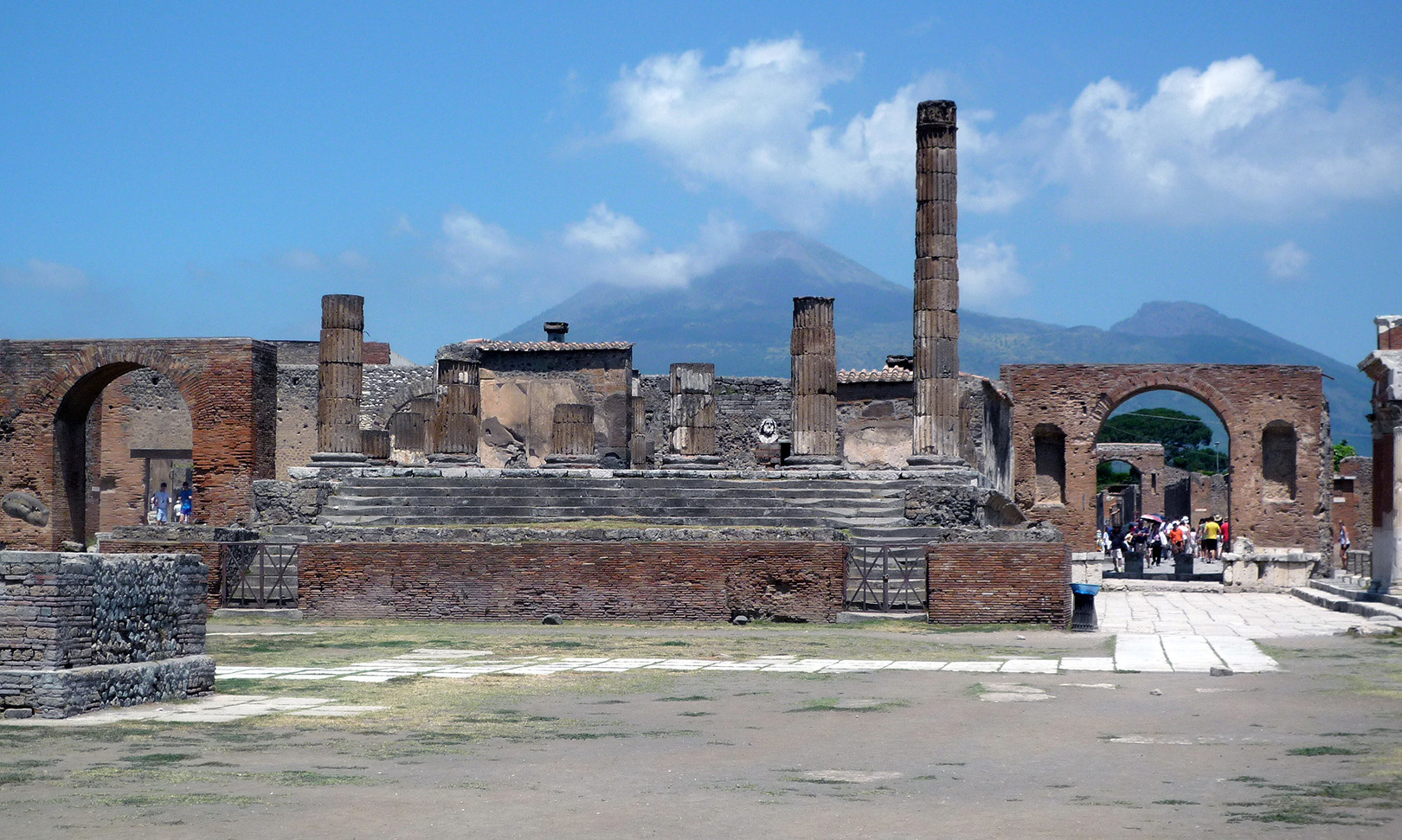
The rediscovery of Pompeii and the other cities of Vesuvius: The field of art history was emerging concurrently with these early excavations.
Read Now >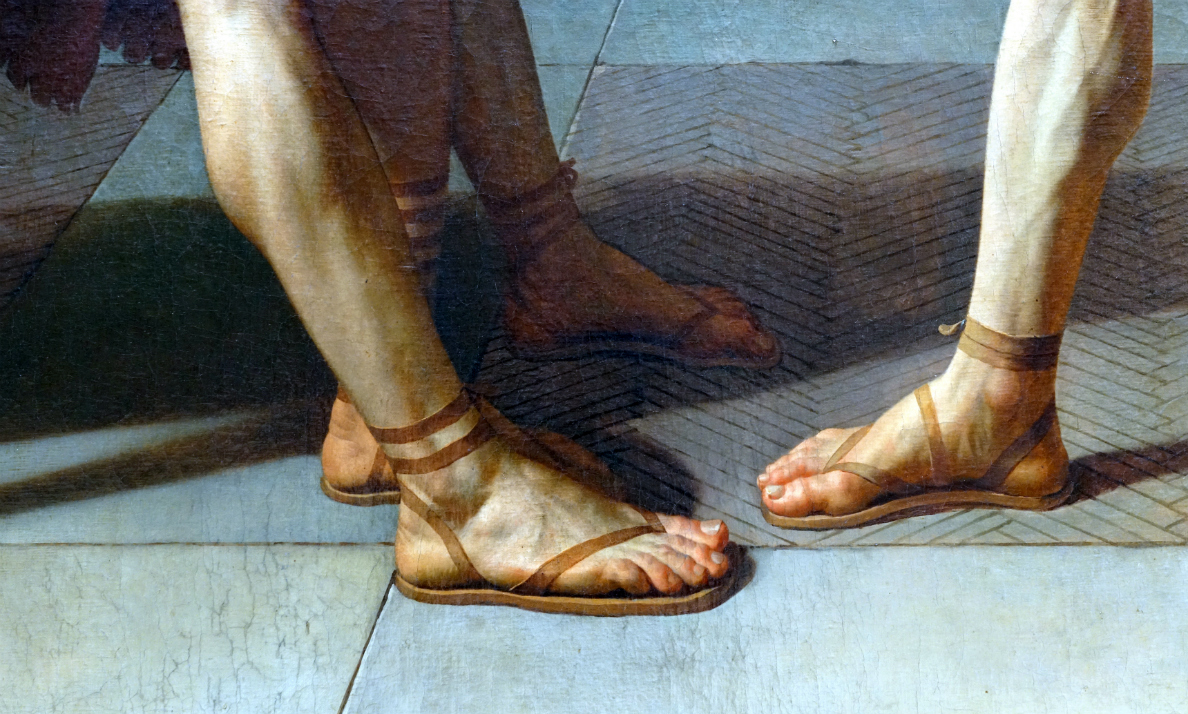
0/2 Completed
The philosophers and philosophes

Jacques-Louis David, Oath of the Horatii, 1784, oil on canvas, 3.3 x 4.25 m, painted in Rome, exhibited at the salon of 1785 (Musée du Louvre; photo: Steven Zucker, CC BY-NC-SA 2.0)
Writers and philosophers—sometimes referred to by the French word philosophes—promoted their new ideas about the role of citizens and self-government in books and pamphlets. As they read the work of writers like John Locke and Jean-Jacques Rousseau, the people of Europe began to think about “natural law” and the ability of people to govern themselves through a “social contract.” Eventually the people of France rose up and broke the belief in the Great Chain of Being—a social order ordained by God that had asserted the divine rule of monarchs since the late middle ages—and proposed, instead, democratic rule and individual liberty. The French Revolution and execution of the French king, Louis XVI, profoundly shook other European monarchies. Neoclassicism became the visual language of the revolution, and it was a style closely associated with the French painter Jacques-Louis David, discussed in the essay below.
Watch a video and read an essay about David
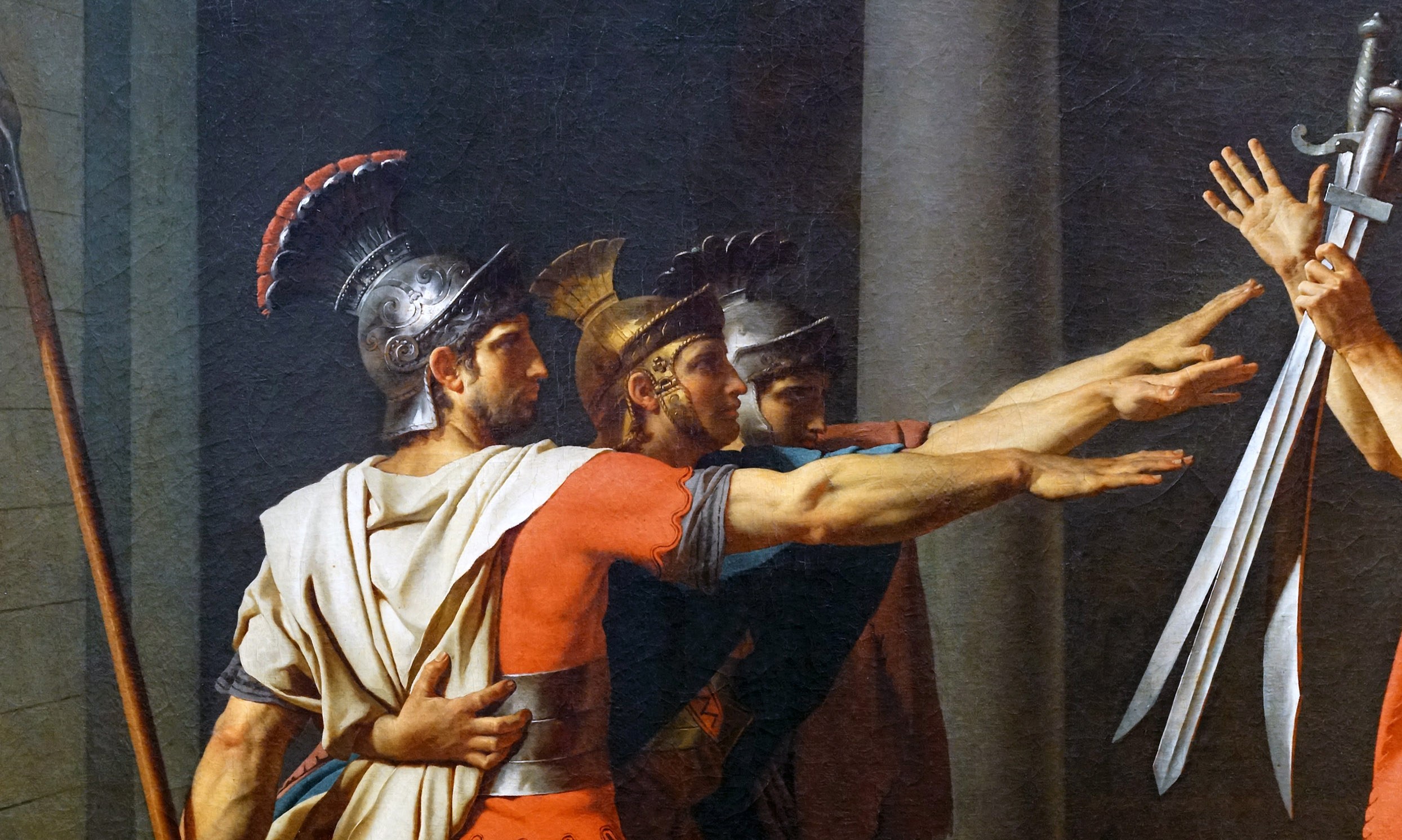
Jacques-Louis David, Oath of the Horatii: Today the painting is typically interpreted in the context of the French Revolution and David’s own direct involvement as a revolutionary.
Read Now >0/1 Completed
The problem of the Enlightenment—freedom for all or freedom for some?
The early years of the French Revolution saw the development of the Declaration of the Rights of Man and of the Citizen (1789), a statement of principles to guide the new French government.
Declaration of the Rights of Man and of the Citizen
1. Men are born and remain free and equal in rights. Social distinctions may be founded only upon the general good.
2. The aim of all political association is the preservation of the natural and imprescriptible rights of man. These rights are liberty, property, security, and resistance to oppression.
3. The principle of all sovereignty resides essentially in the nation. No body nor individual may exercise any authority which does not proceed directly from the nation.
4. Liberty consists in the freedom to do everything which injures no one else; hence the exercise of the natural rights of each man has no limits except those which assure to the other members of the society the enjoyment of the same rights. These limits can only be determined by law. […]
Approved by the National Assembly of France, August 26, 1789
Drafted by the Marquis de Lafayette, in consultation with the American statesman Thomas Jefferson, it offered the vote to male property owners—a very small portion of the overall population. Women, the poor, and immigrants were not given the vote. Slavery had been illegal in France itself for centuries, but the Revolution abolished slavery in some of the French colonies for a short time. Imperfect as it seems today, the Declaration had a profound impact across the world.
Chaos versus Order—the rise of Napoleon and expansion of French power
The tumult of the French Revolution resolved with the emergence of a single leader, Napoleon Bonaparte, who eventually assumed the title of Emperor of the French. Unlike a king, he was not divinely ordained but instead an army officer from Corsica who rose to power through his own abilities—at least that is how the story is often told. As time went on, Napoleon became every inch an emperor, ruling France as a dictator, and leading the nation into wars of conquest in Europe and North Africa until his ultimate defeat at the Battle of Waterloo in 1815.
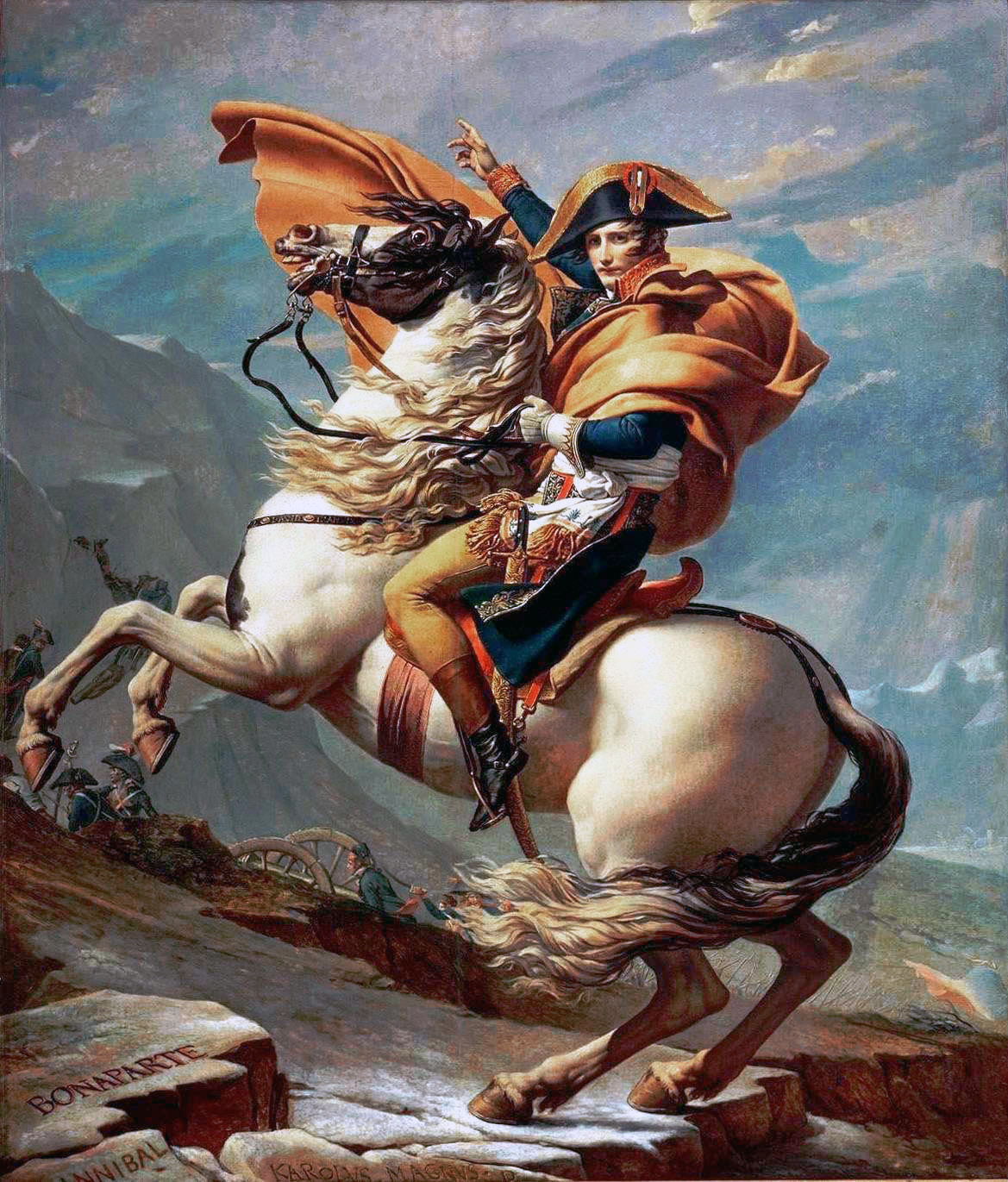
Jacques-Louis David, Napoleon Crossing the Alps or Bonaparte at the St Bernard Pass, 1800–01, oil on canvas, 261 x 221 cm (Chateau de Malmaison, Rueil-Malmaison, photo: Pav.Polish, public domain)
Visualizing Napoleon’s Power
So, who was this man and what role did art play in the expression of his power? Over time Napoleon became the ruler of places like modern Italy and Germany, Spain, Poland, and regions of Scandinavia. He also went to war in North Africa to limit the influence of the Ottomans and the English. To express his role as a conqueror, he employed Jacques-Louis David and his student, Jean-Antoine Gros, among other artists. Sometimes he was depicted as a man who was almost god-like in his command over man and nature, as in the image of him triumphantly crossing the Swiss Alps into Italy on a mighty steed. At other times, viewers could find him among his soldiers as a compassionate man of the people, unafraid to confront the danger of contagion, as Gros showed him in his painting of the plague hospital in Jaffa.
Watch a video and read an essay about visualizing Napoleon's power
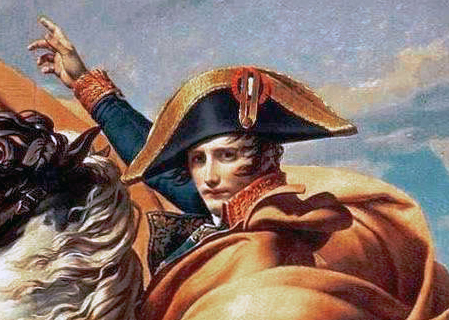
Jacques-Louis David, Napoleon Crossing the Alps: The fact that Napoleon did not actually lead his troops over the Alps but followed a couple of days after them, traveling on a narrow path on the back of a mule is not the point of this painting about power.
Read Now >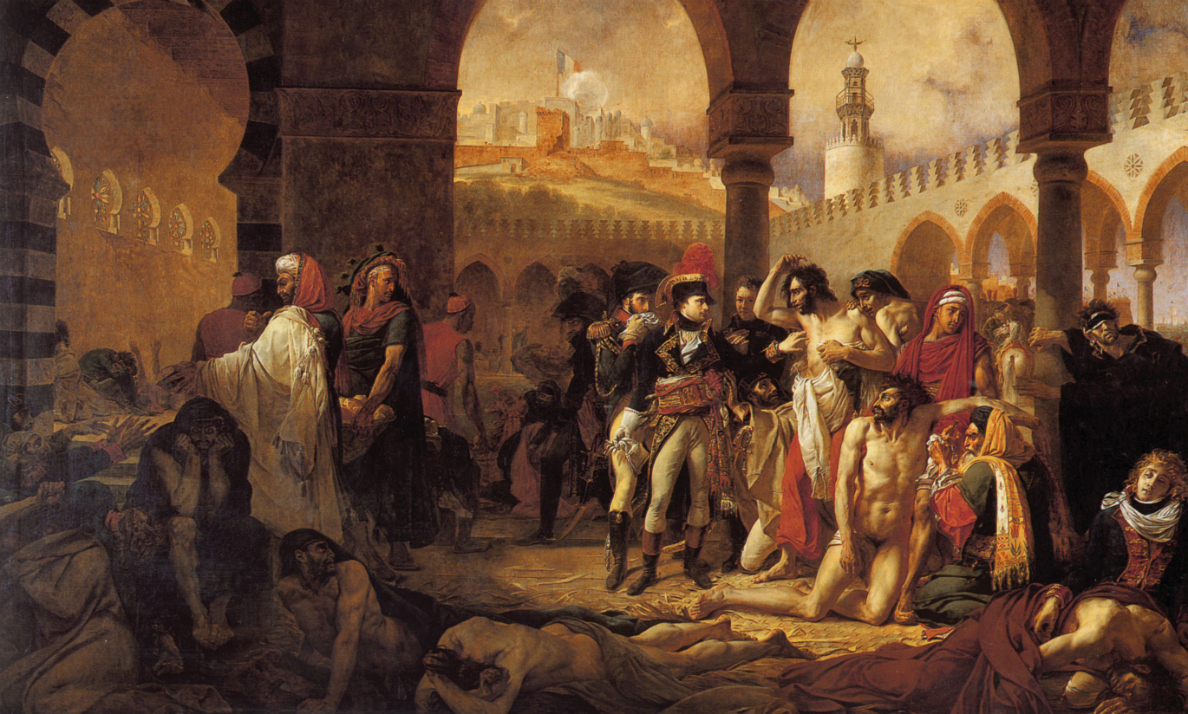
Baron Antoine-Jean Gros, Napoleon Bonaparte Visiting the Pest House in Jaffa: Gros depicts Napoleon attempting to calm the growing panic about contagion by fearlessly touching the sores of one of the plague victims.
Read Now >0/2 Completed
The costs of power

Francisco Goya, And there’s nothing to be done (Y no hai remedio), plate 15 from The Disasters of War (Los Desastres de la Guerra), 1810, etching, drypoint, burin and burnisher, 14 x 16.7 cm (The Metropolitan Museum of Art)
The brutality of war
For many in France, Napoleon’s conquests represented the zenith of French accomplishment as they learned of his successes and viewed the paintings, sculptures and other works that he confiscated from other countries and brought to Paris as spoils of war. While artists like David and Gros created images of Napoleon’s heroism and compassion, for those who suffered conquest the reality was brutal. One artist who expressed the experience of those in Spain was Francisco Goya who saw nothing heroic in the domination of the French. A series of prints, The Disasters of War, created between 1810–14 but not printed until 1863, thirty years after Goya’s death, depicted the violence of war and its tragic aftermath. In his paintings of Spain’s resistance to French domination, like The Third of May 1808 and the prints from The Disasters of War series, Goya focused on those who heroically resisted domination instead of depicting the conquerors.
Read essays and watch a video about Goya's perception of the brutality of war
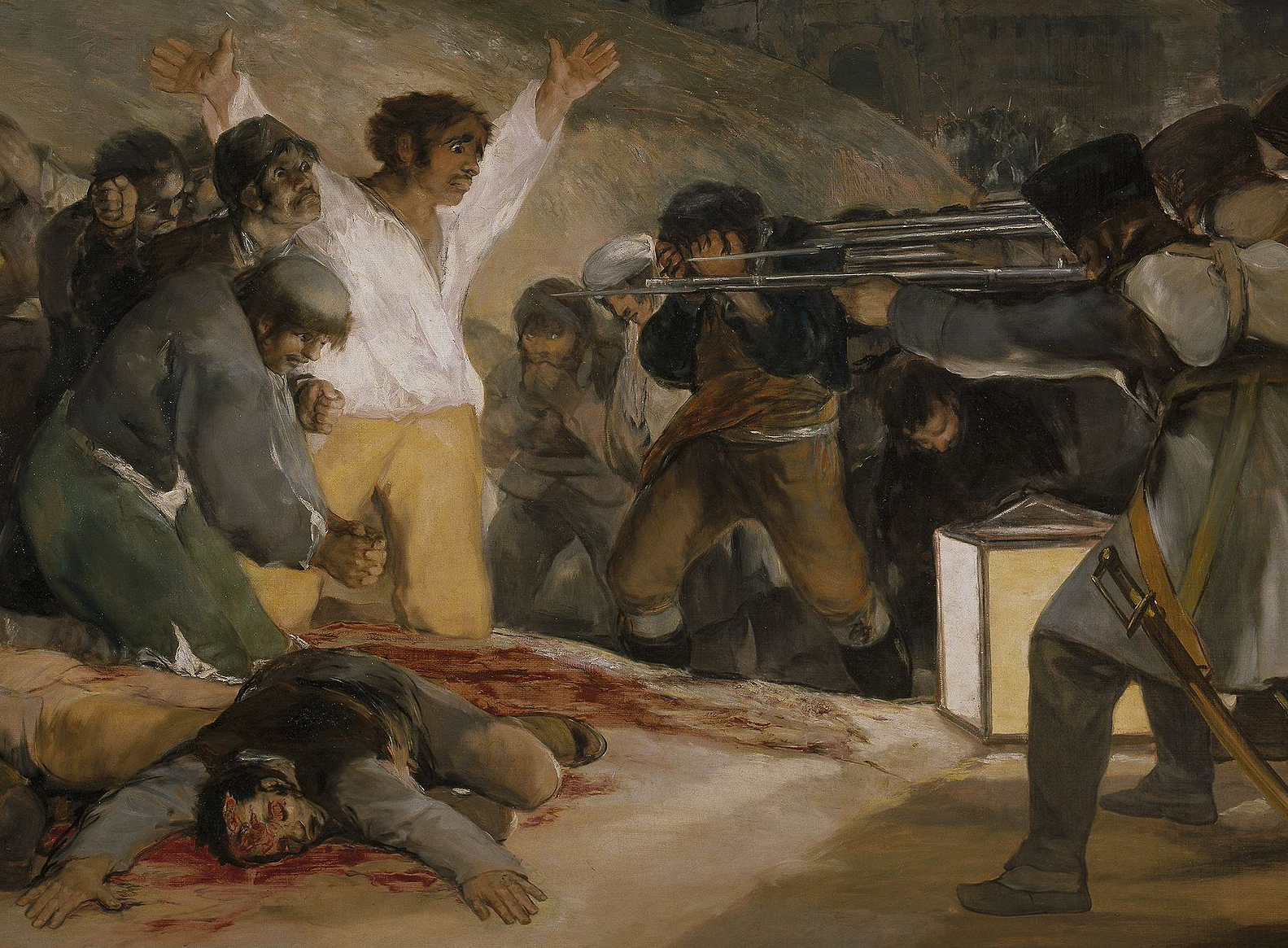
Francisco Goya, The Third of May, 1808: A sinister tale of bloodlust and nepotism led to the tragic events Goya depicts in “the first modern painting.”
Read Now >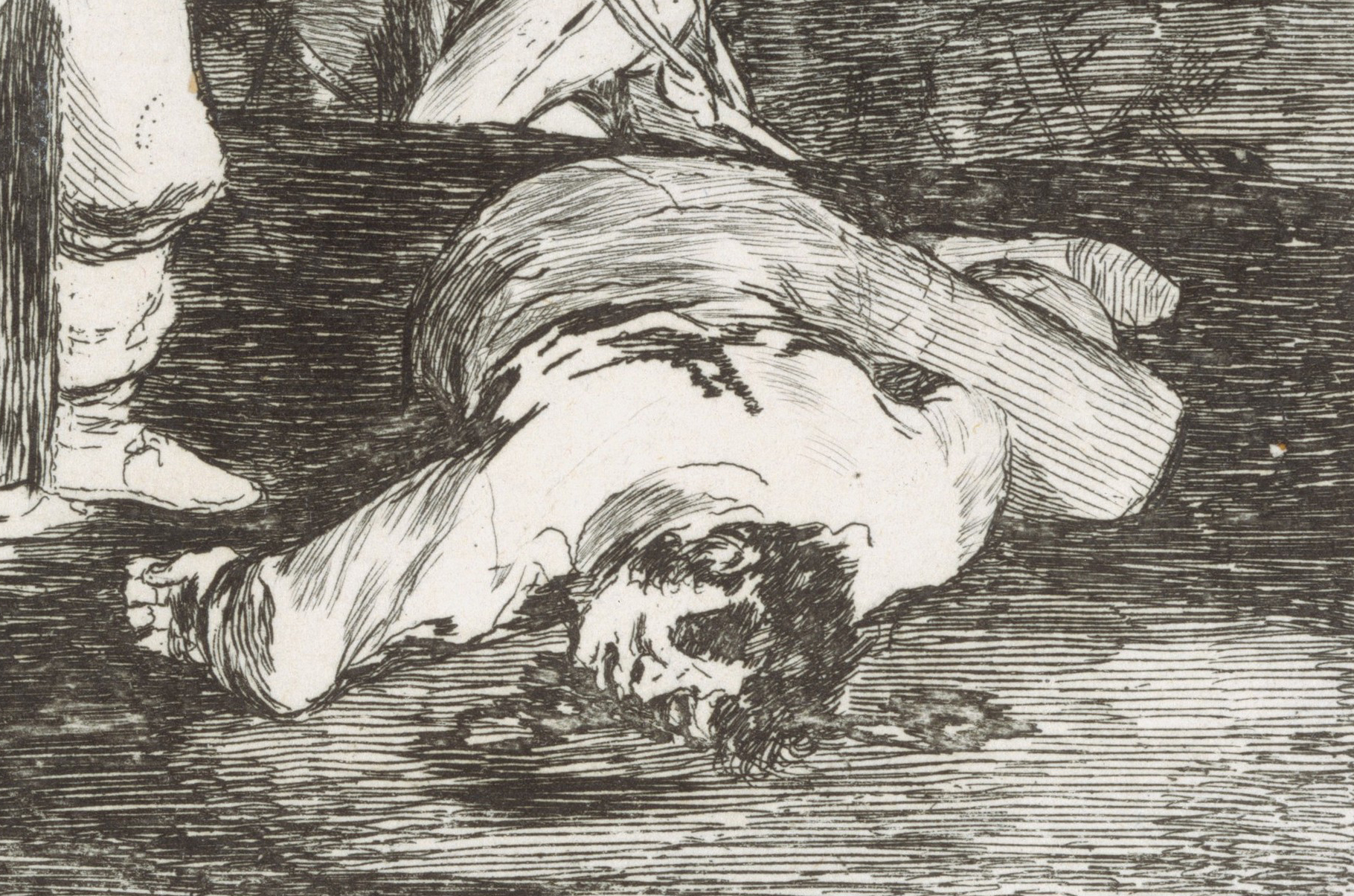
Francisco Goya, And there’s nothing to be done from The Disasters of War: This print wasn’t made public until long after Goya’s death, for fear of exposing his controversial political views.
Read Now >0/2 Completed
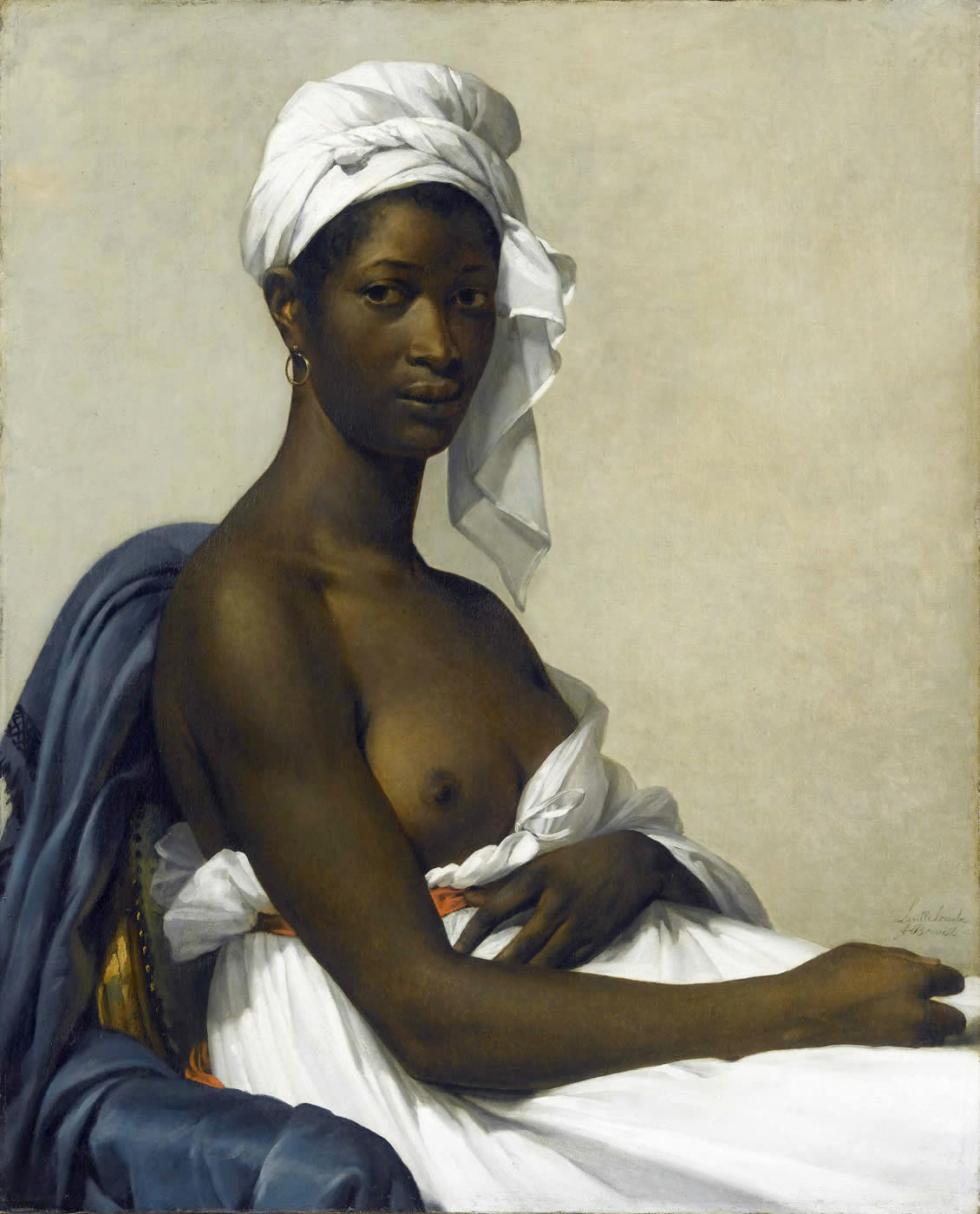
Marie-Guilhelmine Benoist, Portrait d’une négresse, 1800, oil on canvas (Paris, Musée du Louvre)
Slavery and its opponents
The rise of Napoleon had impacts well outside of the European nations themselves. One important debate found its way into the European art of the time: slavery and the slave trade. No European country was untouched by the trade in enslaved people and the debates surrounding it found their way into the art of England and France, for example, throughout the century. In France, slavery had been illegal since the fourteenth century but the French Revolution extended that freedom to the French colonies in 1794. Only eight years later, in 1802, Napoleon reinstated slavery in the French territories outside of France, explored in the essay about Marie-Guillemine Benoist’s Portrait of Madeleine.
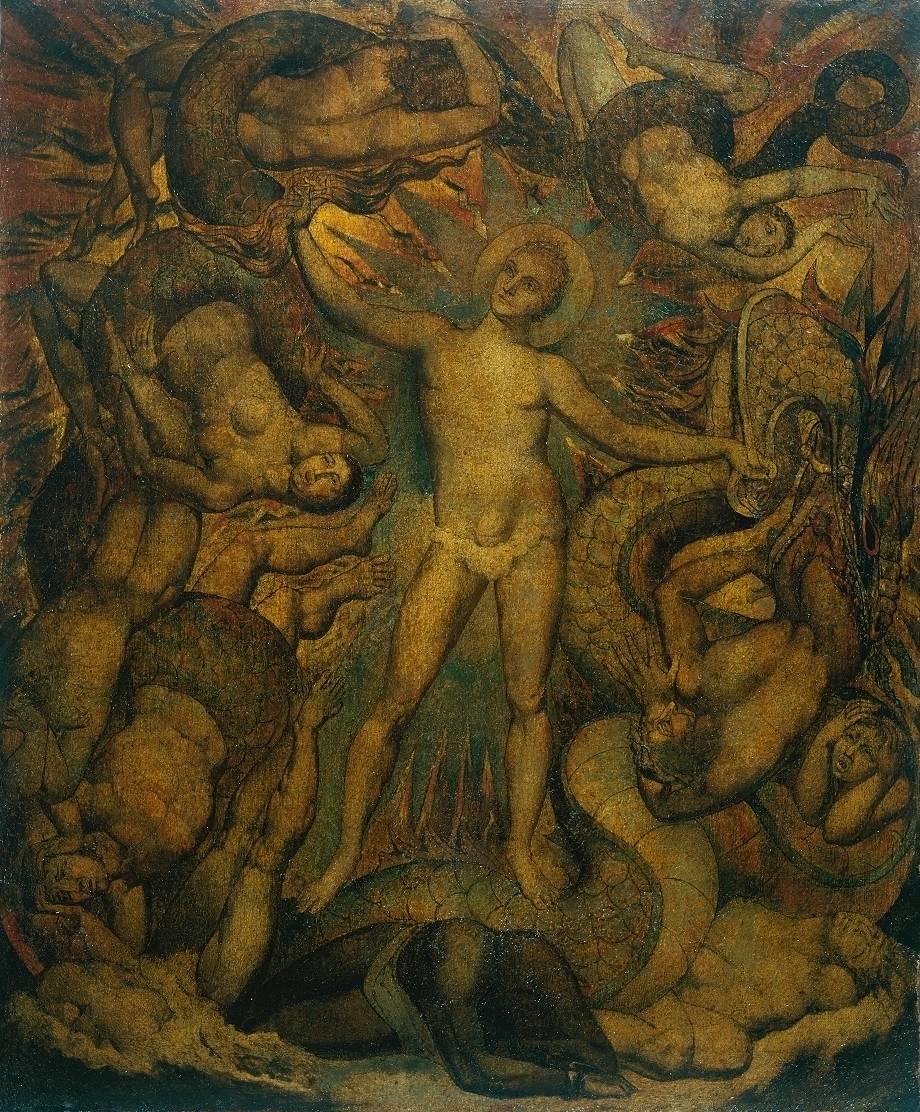
William Blake, The spiritual form of Nelson guiding Leviathan, in whose wreathings are infolded the Nations of the Earth, c. 1805–09, tempera on canvas 30″ x 24″ / 76.2 x 62.5 cm (Tate Britain, London, photo: ALH, public domain)
In his painting, The spiritual form of Nelson guiding Leviathan, the English artist William Blake explored the victory of Admiral Nelson over Napoleon at the Battle of Trafalgar, off of the coast of Spain, and the admiral’s resulting death, in 1805. As he did so, Blake interrogated British connections to India and his own opposition to the slave trade:
Read essays about slavery and its opponents
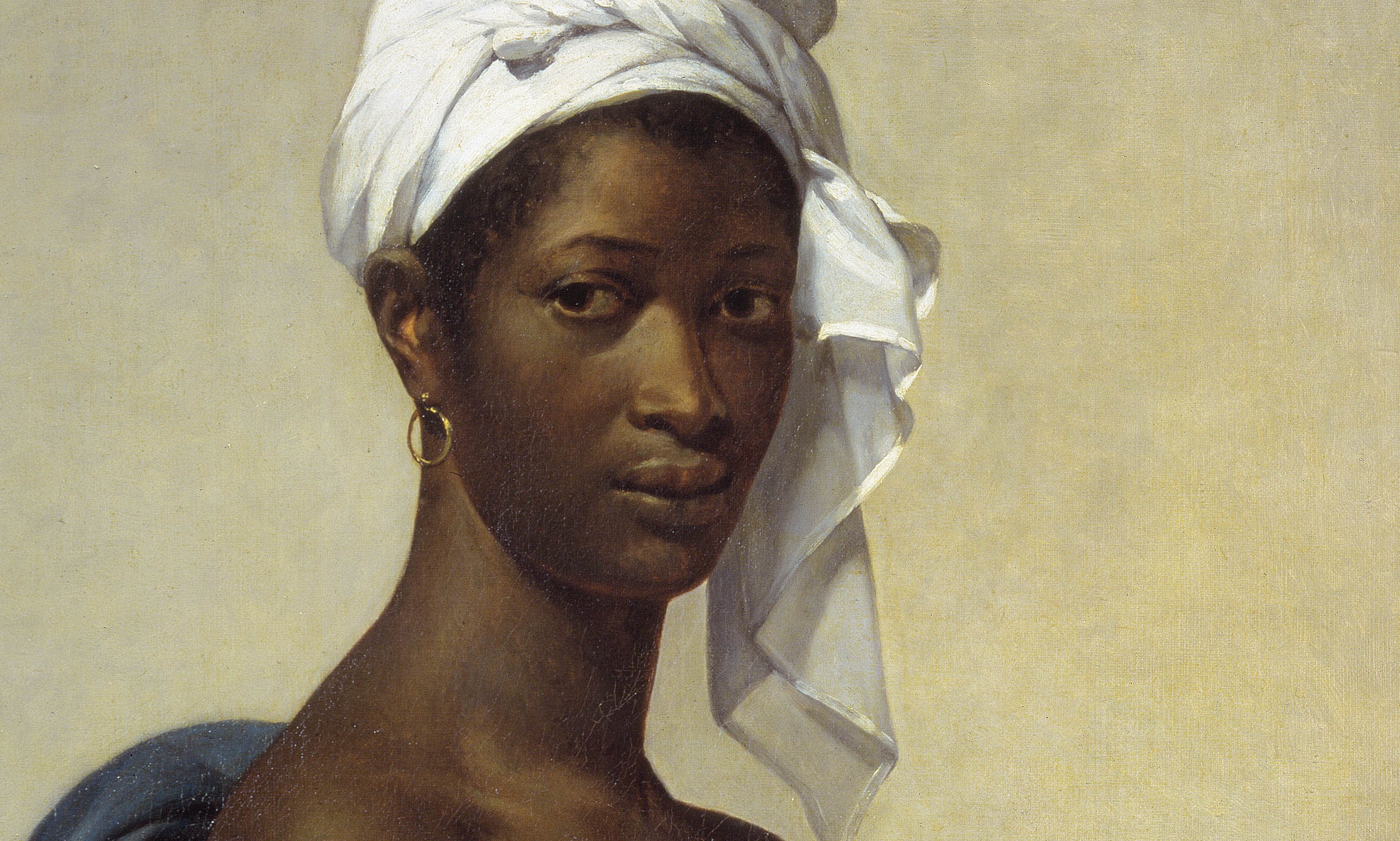
Marie-Guillemine Benoist, Portrait of Madeleine: This portrait of an unnamed woman speaks volumes about slavery, politics, and gender in revolutionary France.
Read Now >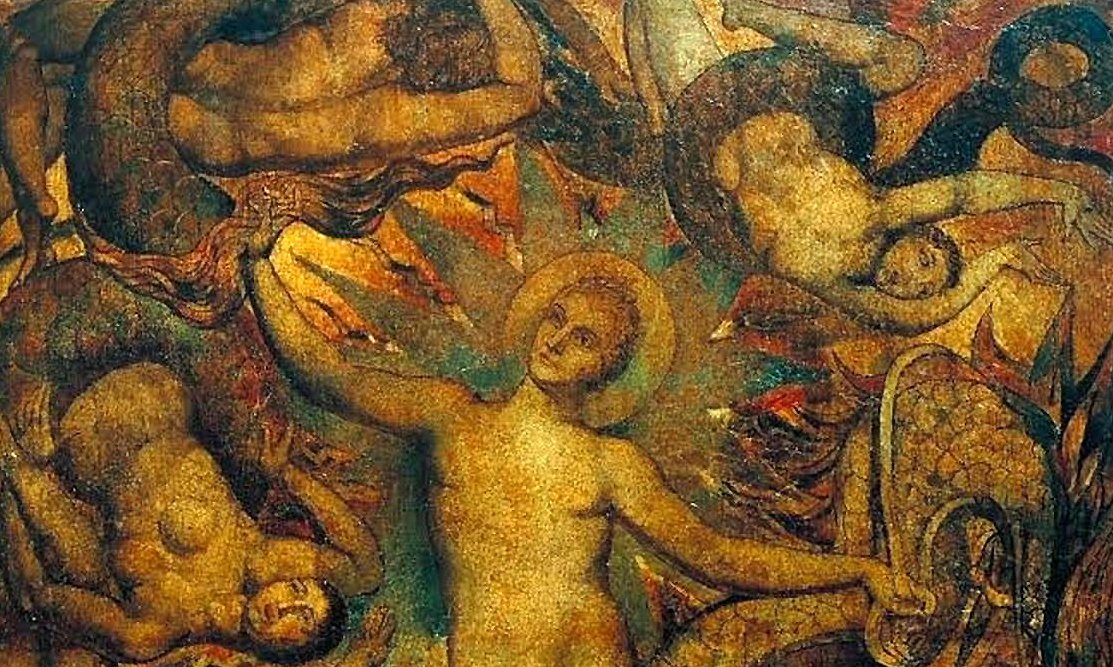
William Blake, The spiritual form of Nelson guiding Leviathan: What do you get if you combine a naval hero, global religious imagery, and an aquatic agent of Satan?
Read Now >0/2 Completed
Colonialist fantasies, looking East
Napoleon’s France was not the only power to seek influence in areas well outside of Europe. The Netherlands, England, Spain, Portugal, Belgium, Italy—all had contacts and power centers through trade, slavery, Christian missions, or colonies. The Netherlands, Portugal, and England, for example, had extensive contacts in East Asia and India as they pursued trade in textiles, spices, and tea beginning in the seventeenth century. What began as trade over time grew into an enterprise that incorporated the use of enslaved laborers from Africa and elsewhere as people and goods traversed the seas.
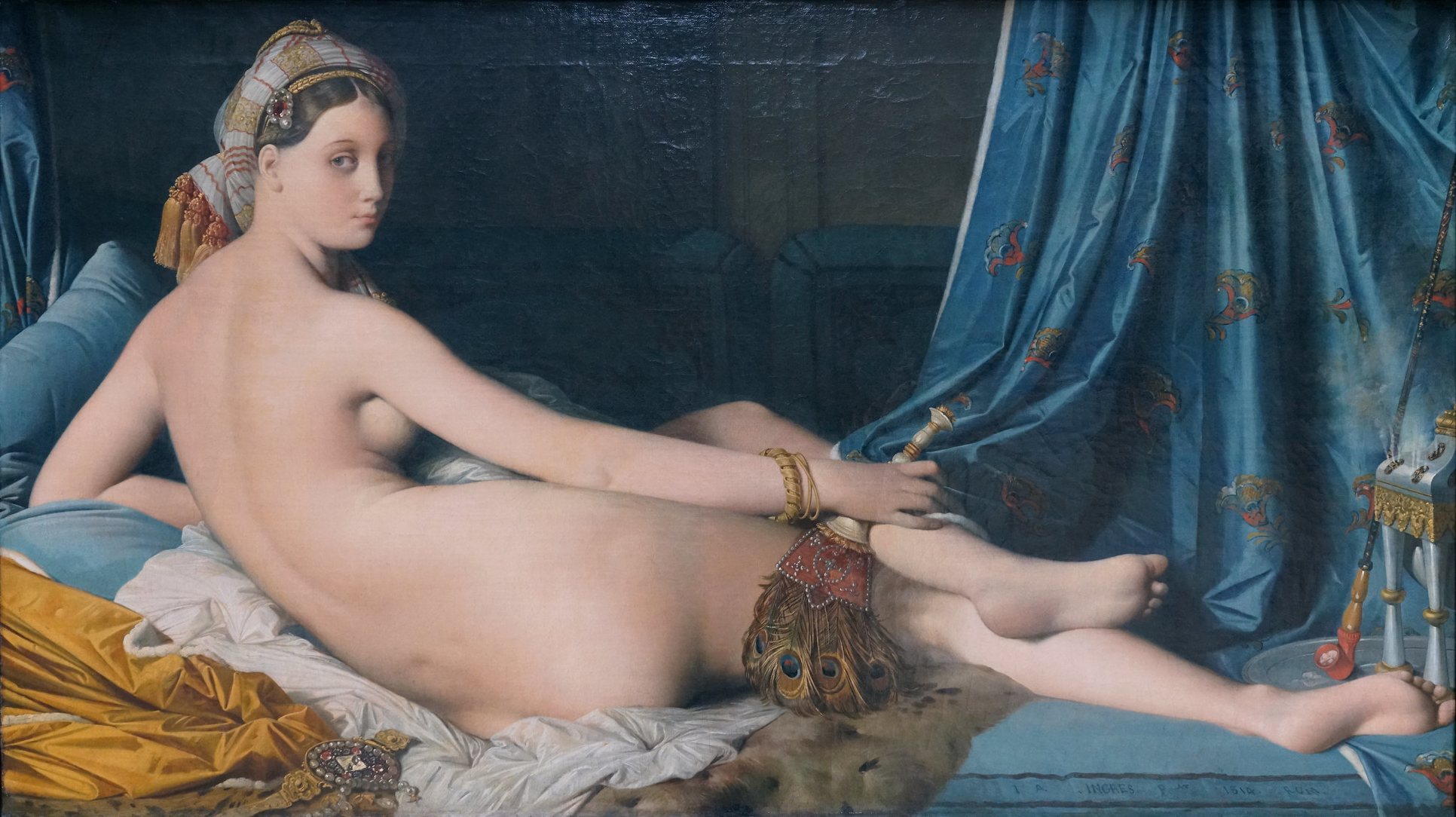
Jean-Auguste-Dominique Ingres, La Grande Odalisque, 1814, oil on canvas, 91 x 162 cm (Louvre, Paris; photo: Steven Zucker, CC BY-NC-SA 2.0)
This growing familiarity with places and people outside of Europe developed into a European mode of representing places like the North Africa, East Asia, and India as distinctly different from (and inferior to) Europe—an approach called “Orientalism.” We can see examples of this fascination with the “Orient” and its expression as an alluring world that exists for the European mind of the nineteenth century as a distinct “other” in a variety of artworks, including John Nash’s Royal Pavilion and cashmere shawls to Jean-Auguste-Dominique Ingres’s Grande Odalisque.
Watch videos and read essays about colonialist fantasies
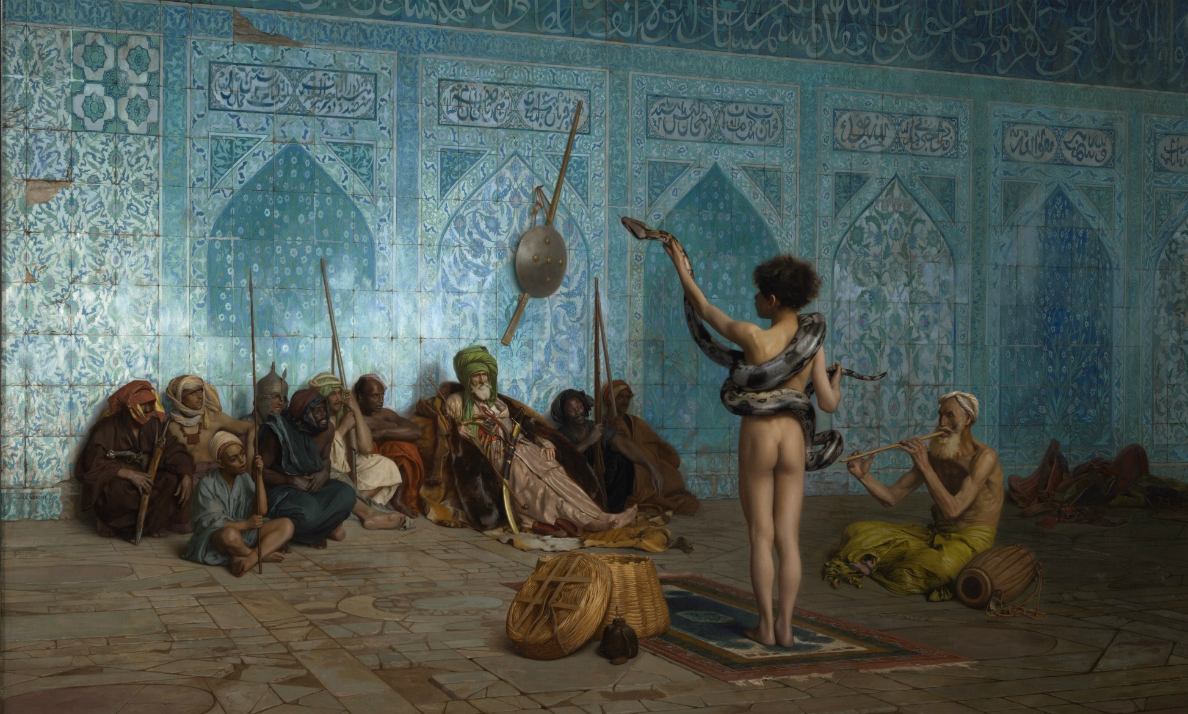
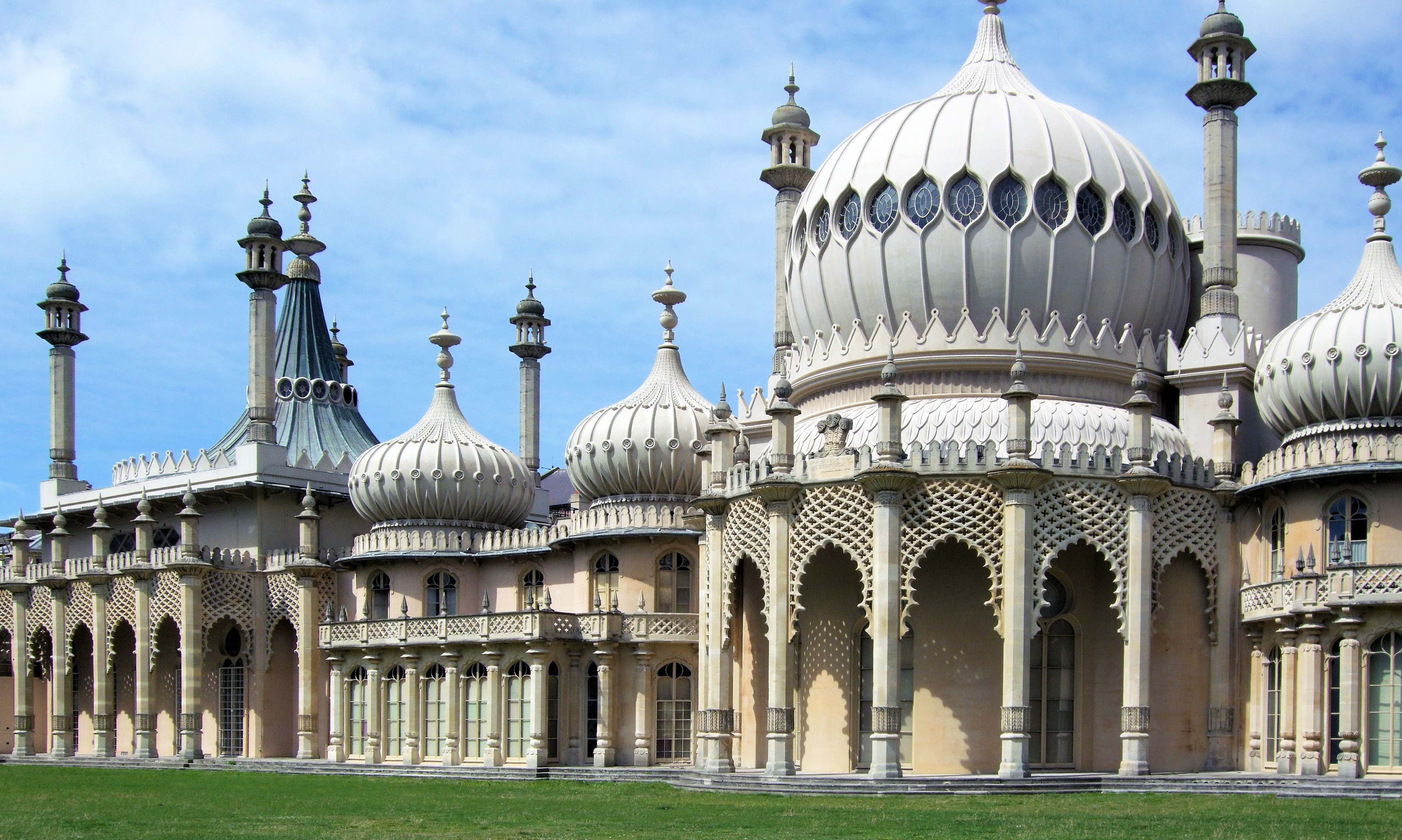
John Nash, Royal Pavilion, Brighton: A prince-regent with a private architect builds a fantasy seaside home mixing all the metaphors of empire.
Read Now >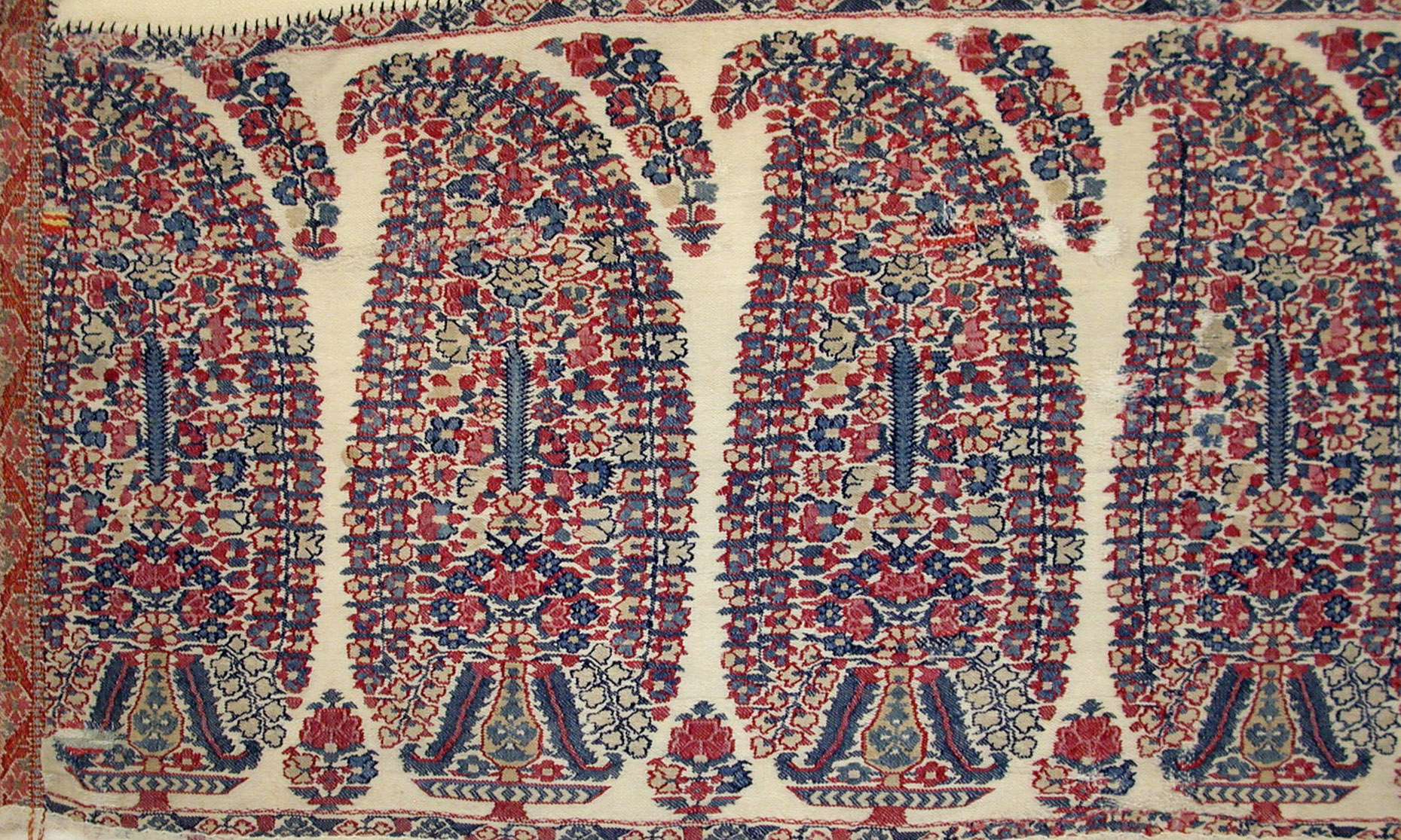
Cashmere shawls: For centuries, handwoven cloth from the Kashmir region of the Indian subcontinent has been revered for its exquisite softness and decorative surface patterns.
Read Now >
Ingres, La Grande Odalisque: Ingres never visited a harem, but he let his imagination run wild in this sensual colonial fantasy.
Read Now >0/4 Completed
The End of Empire
With Napoleon’s final defeat at Waterloo, much of Europe breathed a sigh of relief but, as with many things in the nineteenth century, nothing about that was simply good or bad. For some, like the artist Théodore Géricault, the loss of empire meant a return to the bad old days of monarchy. It may have seemed as if the dream of self-government in the period of the French Revolution had given way to royal incompetence with disastrous consequences. At least that is what was expressed by Géricault in his painting, Raft of the Medusa.

Théodore Géricault, Raft of the Medusa, oil on canvas, 4.91 x 7.16m 1818-19 (Louvre, Paris, photo: Steven Zucker, CC BY-NC-SA 2.0)
Few paintings express the interconnectedness of the nineteenth century world as well as Raft of the Medusa that shows us how decisions made by a handful of people in an office in Paris could affect the lives of some many a continent away.
Watch a video and read an essay about the end of empire
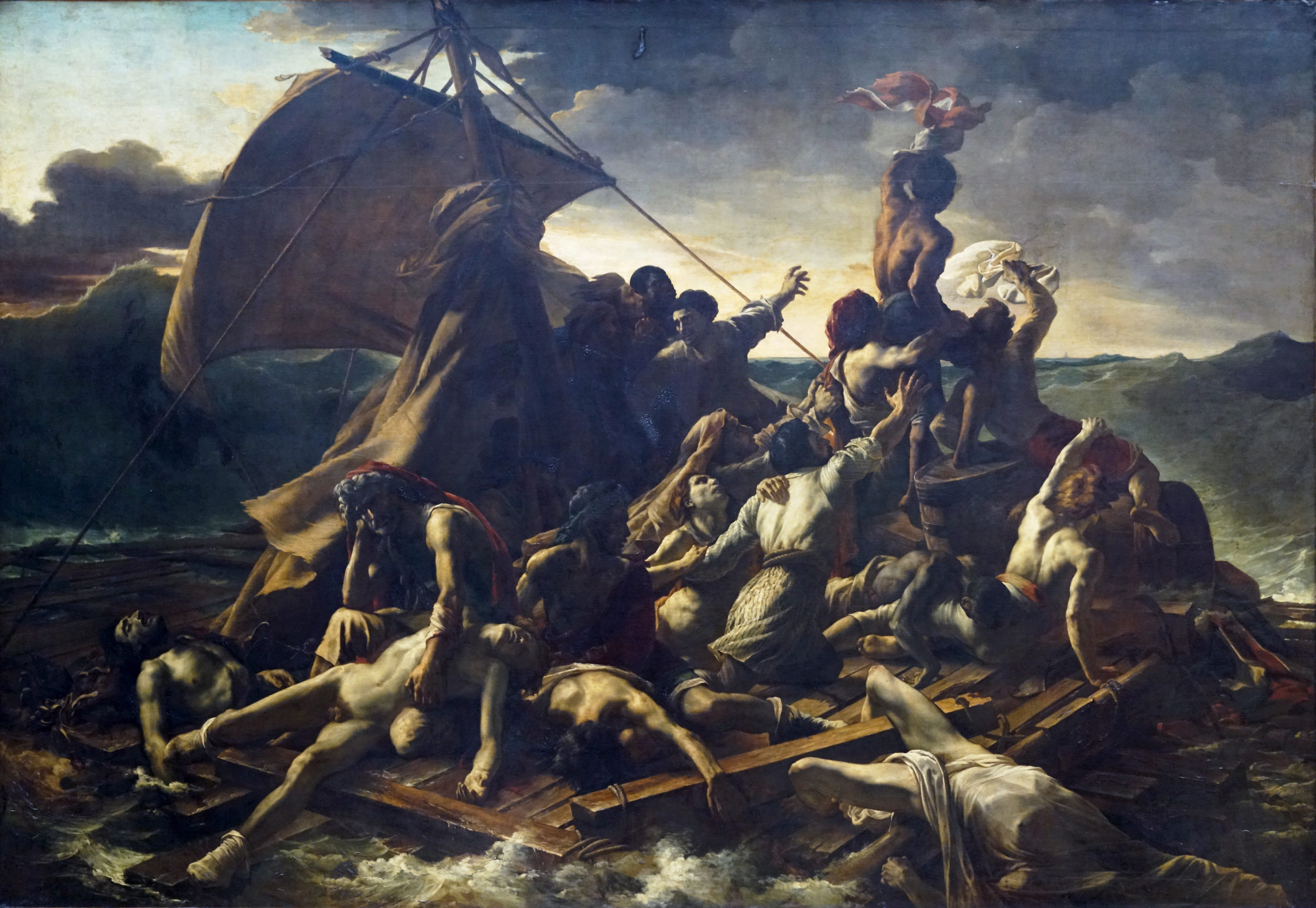
Théodore Géricault, Raft of the Medusa: All of the living people depicted in this striking pyramidal composition eagerly seek rescue, but among them are the dead and dying.
Read Now >0/1 Completed


